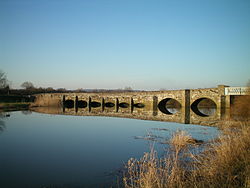Greatham, Sussex
| Greatham | |
| Sussex | |
|---|---|
 Greatham Bridge | |
| Location | |
| Grid reference: | TQ043159 |
| Location: | 50°56’2"N, 0°30’58"W |
| Data | |
| Local Government | |
| Council: | Horsham |
| Parliamentary constituency: |
Arundel and South Downs |
Greatham is a small village in Sussex, on the Coldwaltham to Storrington road about two miles south of Pulborough. It stands on the south side of the River Arun.
History
The Domesday Book of 1086 records the place village as Gretham. The name is recorded as Gretheam in 1121 and Gruteham later in the 12th century. The first element in the name means "gravel"; the second is uncertain, and could mean either "village, estate, manor, homestead", "meadow, especially a flat, low-lying meadow on a stream", or "an enclosed plot, a close".[1]
Greatham Bridge over the River Arun to the west of the village was built for Sir Henry Tregoz in the early 14th century. The iron section was built after floods had damaged the bridge in 1838. A skirmish took place near the bridge during the Civil War.
Early in the First World War, Greatham inspired John Drinkwater's poem Of Greatham (to those who live there), which was published in his anthology Swords and Plough-shares.[2]
Parish church
The village church, which bears no name but 'Greatham Church', is a small, rectangular, single-room parish church. It is similar to that at nearby Wiggonholt, with which it often shared a priest in the Middle Ages. The church is of rubble ironstone walls which have mostly lancet windows and are probably 12th century.
There is a slate-hung bell turret at the western end. Inside are an unusual double decker pulpit and a 17th-century chancel rail.[3]
| ("Wikimedia Commons" has material about Greatham, Sussex) |
References
- ↑ Ekwall, Eilert, The Concise Oxford Dictionary of English Place-Names. Oxford, Oxford University Press, 4th edition, 1960. p. p 204, pp 213–214 ISBN 0198691033
- ↑ Marsh The Project Gutenberg EBook of Georgian Poetry 1913-15 ed. Edward Howard
- ↑ Nikolaus Pevsner: The Buildings of England: Sussex, 1965 Penguin Books ISBN 978-0-300-09677-4page 232
